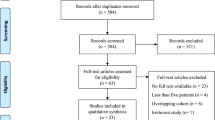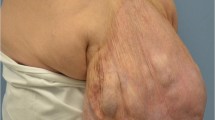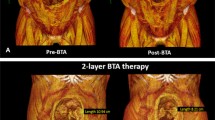Abstract
Objective
We examined the role of botulinum toxin (BTX) injections of anterior scalene (AS) and pectoralis minor (PM) muscles in patients undergoing surgery for neurogenic thoracic outlet syndrome (NTOS). We hypothesized that symptomatic improvement from BTX injections correlates with favorable long-term response to surgery for NTOS.
Materials and methods
This Health Insurance Portability and Accountability Act compliant study was approved by the institutional review board and prior informed consent requirement was waived. We retrospectively analyzed prospectively acquired data in NTOS patients who underwent sonographically guided chemodenervation of AS and PM using BTX type A followed by scalenectomy and first rib resection. Overall responses to BTX injections and surgery were recorded after each procedure. Statistical analyses were performed to determine correlation between responses to BTX injections and surgery.
Results
In 157 patients, 178 BTX injections followed by surgery were identified (114 females; mean age 38 ± 13 years). Responders and non-responders to BTX injections and surgery had similar preoperative symptom duration and age (P > 0.14). Better response to BTX injections correlated positively with better response to surgery (P = 0.003), persisting after adjustment for age, gender, and symptom duration (P = 0.03). A high proportion of responders to BTX injections also responded to surgery (positive predictive value of 99%), and BTX injections showed high specificity (90%). BTX injections were moderately sensitive (66%) and accurate (67%) to determine surgical response and had low negative predictive value (14%).
Conclusion
Response to BTX injections correlates positively with long-term surgical outcome in subjects with NTOS, potentially playing an important role in patient management.


Similar content being viewed by others
References
Demondion X, Herbinet P, Van Sint JS, Boutry N, Chantelot C, Cotten A. Imaging assessment of thoracic outlet syndrome. Radiographics. 2006;26(6):1735–50.
Christo PJ, McGreevy K. Updated perspectives on neurogenic thoracic outlet syndrome. Curr Pain Headache Rep. 2011;15(1):14–21.
Jordan SE, Ahn SS, Freischlag JA, Gelabert HA, Machleder HI. Selective botulinum chemodenervation of the scalene muscles for treatment of neurogenic thoracic outlet syndrome. Ann Vasc Surg. 2000;14(4):365–9.
Jordan SE, Ahn SS, Gelabert HA. Combining ultrasonography and electromyography for botulinum chemodenervation treatment of thoracic outlet syndrome: comparison with fluoroscopy and electromyography guidance. Pain Physician. 2007;10(4):541–6.
Jordan SE, Ahn SS, Gelabert HA. Differentiation of thoracic outlet syndrome from treatment-resistant cervical brachial pain syndromes: development and utilization of a questionnaire, clinical examination and ultrasound evaluation. Pain Physician. 2007;10(3):441–52.
Lum YW, Brooke BS, Likes K, Modi M, Grunebach H, Christo PJPJ, et al. Impact of anterior scalene lidocaine blocks on predicting surgical success in older patients with neurogenic thoracic outlet syndrome. J Vasc Surg. 2012;55(5):1370–5.
Christo PJ, Christo DK, Carinci AJ, Freischlag JA. Single CT-guided chemodenervation of the anterior scalene muscle with botulinum toxin for neurogenic thoracic outlet syndrome. Pain Med. 2010;11(4):504–11.
Torriani M, Gupta R, Donahue DM. Sonographically guided anesthetic injection of anterior scalene muscle for investigation of neurogenic thoracic outlet syndrome. Skelet Radiol. 2009;38(11):1083–7.
Torriani M, Gupta R, Donahue DM. Botulinum toxin injection in neurogenic thoracic outlet syndrome: results and experience using a ultrasound-guided approach. Skelet Radiol. 2010;39(10):973–80.
Donahue DM. Supraclavicular 1st rib resection. Oper Tech Thorac Cardiovasc Surg. 2011;16(4):252–66.
Caputo FJ, Wittenberg AM, Vemuri C, Driskill MR, Earley JA, Rastogi R, et al. Supraclavicular decompression for neurogenic thoracic outlet syndrome in adolescent and adult populations. J Vasc Surg. 2013;57(1):149–57.
Vemuri C, Wittenberg AM, Caputo FJ, Earley JA, Driskill MR, Rastogi R, et al. Early effectiveness of isolated pectoralis minor tenotomy in selected patients with neurogenic thoracic outlet syndrome. J Vasc Surg. 2013;57(5):1345–52.
Povlsen B, Hansson T, Povlsen SD. Treatment for thoracic outlet syndrome. Cochrane Database Syst Rev. 2014;11:Cd007218.
Rochlin DH, Likes KC, Gilson MM, Christo PJ, Freischlag JA. Management of unresolved, recurrent, and/or contralateral neurogenic symptoms in patients following first rib resection and scalenectomy. J Vasc Surg. 2012;56(4):1061–7 discussion 1068.
Seyler TM, Smith BP, Marker DR, Ma J, Shen J, Smith TL, et al. Botulinum neurotoxin as a therapeutic modality in orthopaedic surgery: more than twenty years of experience. J Bone Joint Surg Am. 2008;90(Suppl 4):133–45.
Wheeler A, Smith HS. Botulinum toxins: Mechanisms of action, antinociception and clinical applications. Toxicology. 2013;306:124–46.
Ishikawa H, Mitsui Y, Yoshitomi T, Mashimo K, Aoki S, Mukuno K, et al. Presynaptic effects of botulinum toxin type A on the neuronally evoked response of albino and pigmented rabbit iris sphincter and dilator muscles. Jpn J Ophthalmol. 2000;44(2):106–9.
Likes KC, Orlando MS, Salditch Q, Mirza S, Cohen A, Reifsnyder T, et al. Lessons learned in the surgical treatment of neurogenic thoracic outlet syndrome over 10 years. Vasc Endovasc Surg. 2015;49(1–2):8–11.
Orlando MS, Likes KC, Mirza S, Cao Y, Cohen A, Lum YW, et al. A decade of excellent outcomes after surgical intervention in 538 patients with thoracic outlet syndrome. J Am Coll Surg. 2015;220(5):934–9.
Sanders RJ, Hammond SL, Rao NM. Thoracic outlet syndrome: a review. Neurologist. 2008;14(6):365–73.
Sanders RJ, Hammond SL. Supraclavicular first rib resection and total scalenectomy: technique and results. Hand Clin. 2004;20(1):61–70.
Sanders RJ, Annest SJ. Technique of supraclavicular decompression for neurogenic thoracic outlet syndrome. J Vasc Surg. 2015;61(3):821–5.
Franklin GM. Work-related neurogenic thoracic outlet syndrome: diagnosis and treatment. Phys Med Rehabil Clin N Am. 2015;26(3):551–61.
Chang DC, Rotellini-Coltvet L. a., Mukherjee D, De Leon R, Freischlag J a. Surgical intervention for thoracic outlet syndrome improves patient’s quality of life. J Vasc Surg. 2009;49(3):630–7.
Rochlin DH, Gilson MM, Likes KC, Graf E, Ford N, Christo PJ, et al. Quality-of-life scores in neurogenic thoracic outlet syndrome patients undergoing first rib resection and scalenectomy. J Vasc Surg. 2013;57(2):436–43.
Finlayson HC, O’Connor RJ, Brasher PM, Travlos A. Botulinum toxin injection for management of thoracic outlet syndrome: A double-blind, randomized, controlled trial. Pain. 2011;152(9):2023–8.
Author information
Authors and Affiliations
Corresponding author
Ethics declarations
Conflicts of interest
The authors declare that they have no conflicts of interest.
Ethical approval
All procedures performed in studies involving human participants were carried out in accordance with the ethical standards of the institutional and/or national research committee and with the 1964 Declaration of Helsinki and its later amendments or comparable ethical standards.
Informed consent
Informed consent was waived for individual participants included in the study. The study was approved by the local Institutional Review Board (IRB) and HIPAA compliant.
Additional information
Publisher’s note
Springer Nature remains neutral with regard to jurisdictional claims in published maps and institutional affiliations.
Rights and permissions
About this article
Cite this article
Donahue, D.M., Godoy, I.R.B., Gupta, R. et al. Sonographically guided botulinum toxin injections in patients with neurogenic thoracic outlet syndrome: correlation with surgical outcomes. Skeletal Radiol 49, 715–722 (2020). https://doi.org/10.1007/s00256-019-03331-9
Received:
Revised:
Accepted:
Published:
Issue Date:
DOI: https://doi.org/10.1007/s00256-019-03331-9




